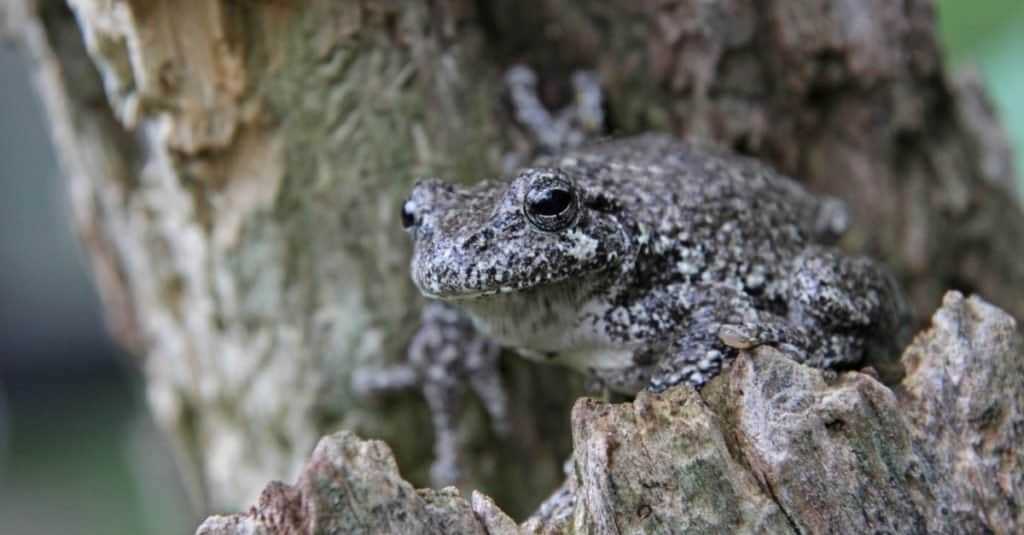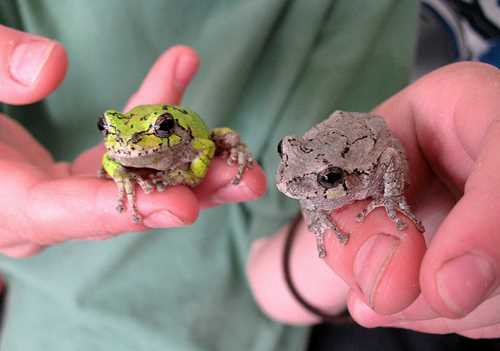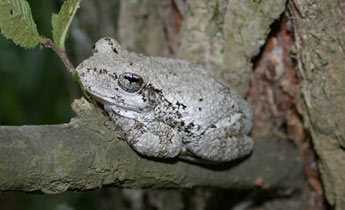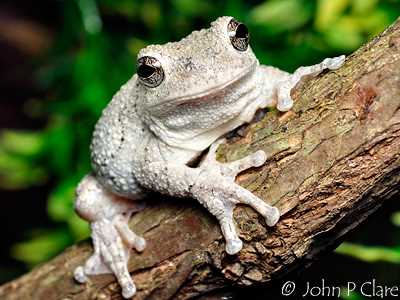
But are gray tree frogs poisonous? This is a question that often arises when discussing these remarkable amphibians. Some believe that their gray coloration is a warning sign, indicating that they are toxic and potentially harmful. Others argue that their color is simply a form of camouflage, allowing them to blend in with their surroundings.
So, which is it? Are gray tree frogs truly poisonous, or are they harmless creatures? The truth may surprise you. While it is true that some species of frogs are indeed venomous, the gray tree frog is not one of them. In fact, they are completely harmless to humans.
Contrary to popular belief, the gray coloration of these frogs is not an indication of toxicity. It is simply a natural adaptation that allows them to hide from predators and blend in with tree bark or rocks. Their ability to change color also helps them camouflage themselves even better. So if you come across a gray tree frog, you have nothing to fear!
Appearance and Habitat
The Gray Tree Frogs are a fascinating species of frogs known for their unique appearance and habitat. These frogs are small in size, typically measuring around 1.5 to 2.5 inches in length. They have a compact and moderate build, with smooth skin that can range in color from light gray to green or brown. Their skin is often covered in small bumps and irregular markings, helping them blend into their surroundings.
Gray Tree Frogs are predominantly found in the eastern regions of North America, ranging from parts of Canada down to the Gulf Coast of the United States. They have a wide habitat range that extends across deciduous forests, mixed forests, and even suburban areas with suitable vegetation.
Diet and Feeding Habits of Gray Tree Frogs

Feeding Habits
The diet of gray tree frogs mainly consists of insects such as flies, mosquitoes, beetles, and moths. They are skilled hunters and have adapted to living in trees, using their sticky toe pads to climb and leap from branch to branch. This allows them to easily catch flying insects in mid-air.
Gray tree frogs are also known to eat other small invertebrates such as spiders, snails, and worms. They have a voracious appetite and can consume a significant number of insects in a single night.
Feeding Behavior
When hunting, gray tree frogs use their large, protruding eyes to locate prey. They have excellent vision and can spot small insects from a distance. Once they spot their prey, they extend their sticky tongues to catch it. Their tongues are covered in mucus, which helps them to secure their prey and pull it into their mouth.
Gray tree frogs are capable of remarkable precision when aiming for their prey. They can accurately shoot their tongues out at high speed, ensuring a successful catch. This is particularly useful when targeting fast-moving insects like flies.
Feeding Frequency
Gray tree frogs are nocturnal creatures and are most active during the night when their prey is abundant. They feed primarily at dusk and dawn when insects are more active. They have a high metabolism and need to consume food regularly to sustain their energy levels.
The feeding frequency of gray tree frogs depends on factors such as temperature, humidity, and availability of prey. During favorable conditions, they can feed every night. However, during colder months or when food sources are scarce, their feeding frequency may decrease.
Overall, the diet and feeding habits of gray tree frogs play a crucial role in their survival and overall health. Their ability to catch a wide range of insects and adapt to different environments has contributed to their success as a species.
Reproduction and Lifespan
During this time, the males produce a distinctive and loud mating call that can be heard from a considerable distance. They use this call to attract females and to establish their territory. These calls can be quite deafening when multiple frogs are calling at the same time.
Once a male has attracted a female, they will engage in amplexus, where the male clasps onto the female’s back. The female then lays her eggs, and the male fertilizes them externally by releasing his sperm. The eggs are laid in clusters attached to vegetation or other objects in the water.
The eggs hatch into tadpoles after about a week. The tadpoles then go through a metamorphosis process, where they develop limbs and absorb their tail. This process takes a few weeks, and eventually, the tadpoles transform into juvenile frogs. These young frogs will leave the water and become terrestrial adults.
Gray Tree Frogs have a relatively short lifespan compared to some other frog species. They typically live for about 3-5 years in the wild. However, in captivity, they can live for up to 10 years with proper care and nutrition.
Predators and Defense Mechanisms
Gray tree frogs have several predators in their natural habitat, including birds, snakes, and small mammals. To protect themselves from these predators, gray tree frogs have developed various defense mechanisms.
One of the most effective defense mechanisms of gray tree frogs is their ability to change color. They can change their skin color from green to gray or brown to match the surrounding environment, making it difficult for predators to spot them.
In addition to their camouflage abilities, gray tree frogs also have adhesive toe pads that help them cling to surfaces. This allows them to stay hidden among foliage or climb trees, making it harder for predators to reach them.
Another defense mechanism of gray tree frogs is their ability to emit a loud and high-pitched trilling sound. This sound can startle predators, giving the frogs a chance to escape. The trilling sound is produced by males during the breeding season to attract females, but it can also serve as a warning to potential threats.
| Predators of Gray Tree Frogs | Defense Mechanisms |
|---|---|
| Birds | Camouflage, adhesive toe pads, puffing up, trilling sound |
| Snakes | Camouflage, adhesive toe pads, puffing up, trilling sound |
| Small mammals | Camouflage, adhesive toe pads, puffing up, trilling sound |
Overall, gray tree frogs have evolved a range of defense mechanisms to survive in their environment. These adaptations have helped them avoid predation and thrive in various habitats.
Is Gray Tree Frog Poisonous?
These toxins can cause harm or even be deadly to animals that try to eat the gray tree frogs. The toxic compounds produced by these frogs are a mixture of alkaloids and peptides, which can be irritating or toxic to predators.
When threatened, gray tree frogs may release their toxins as a form of self-defense. They can secrete a milky-white, sticky substance from their skin, which acts as a deterrent to predators. This secretion not only makes them unpalatable but also sticks to the predator’s mouth, making it difficult to swallow or digest the frog.
Gray Tree Frogs: Toxicity and Health Risks
| Substance | Toxicity Level |
|---|---|
| Batrachotoxin | Highly toxic |
| Bufotoxin | Mildly toxic |
Their toxin contains compounds such as batrachotoxin, which is highly toxic, and bufotoxin, which is mildly toxic. While the toxicity levels are not as potent as those found in certain poisonous frogs, caution should still be exercised when handling gray tree frogs or allowing them to come into contact with vulnerable areas of the body.
In humans, contact with the toxins secreted by gray tree frogs can cause irritation, redness, or swelling of the skin. In rare cases, more severe reactions such as allergic reactions or respiratory difficulties may occur. It is advisable to wash hands thoroughly after handling gray tree frogs or any surfaces they have come into contact with.
While gray tree frogs do possess toxins that can be harmful, they are not considered a significant threat to human health as long as proper precautions are taken. With awareness and responsible handling, we can appreciate these fascinating creatures without endangering ourselves or the frogs.
Gray Tree Frogs as Pets
Many people wonder if gray tree frogs can be kept as pets. The good news is that these frogs can indeed make fascinating pets for amphibian enthusiasts. However, there are a few things to consider before deciding to keep a gray tree frog as a pet.
It’s also crucial to maintain the right temperature and humidity levels within the enclosure. Gray tree frogs are ectothermic, meaning that their body temperature is regulated by their environment. Therefore, it’s essential to provide a temperature gradient and a humidity level that allows the frogs to thermoregulate and stay healthy.
In summary, gray tree frogs can be kept as pets, but it’s essential to provide them with a suitable enclosure, proper temperature and humidity levels, and a varied diet. It’s also important to consider the potential noise level and disturbance the frogs may cause. With the right care and attention, gray tree frogs can make fascinating additions to any amphibian lover’s home.
The Conservation Status of Gray Tree Frogs
Gray tree frogs are a unique species of frogs known for their ability to change colors depending on their surroundings. They are found in North America, particularly in the eastern and central parts of the continent. These frogs are not poisonous and do not pose any health risks to humans or other animals.
Importance of Conservation
The decline of gray tree frogs may have a negative impact on the ecosystem. As amphibians, they serve as an indicator species, meaning their presence or absence can indicate the overall health of an ecosystem. Their tadpoles feed on algae and other organic matter, helping to balance aquatic systems. Additionally, these frogs are an important food source for certain predators, such as birds and snakes, contributing to the overall biodiversity of their habitats.
Conservation Measures
Several conservation measures are being implemented to protect gray tree frogs and their habitats. These include:
- Creating and maintaining protected areas: Establishing protected areas, such as national parks and wildlife reserves, helps to preserve the natural habitats of gray tree frogs. These areas provide a safe haven where frogs can reproduce and thrive without human disturbance.
- Restoring degraded habitats: Efforts are being made to restore degraded habitats, such as reforesting areas that have been cleared for agriculture or urban development. This helps to create suitable habitats for gray tree frogs and other wildlife.
- Raising awareness: Education and public outreach programs are crucial in raising awareness about the importance of gray tree frogs and the need to protect their habitats. By informing the public about the threats facing these frogs, people can become more engaged in conservation efforts.
By implementing these conservation measures, we can help ensure the survival of gray tree frogs for future generations. The protection of these unique amphibians is not only important for their own sake but also for the overall health and balance of the ecosystems they inhabit.
Interesting Facts about Gray Tree Frogs
-
Camouflage Experts:
Gray tree frogs have the incredible ability to change their skin color to match their surroundings. This helps them blend in and hide from predators.
-
Nocturnal Creatures:
These frogs are primarily active at night, making them nocturnal animals. They can be found climbing on trees and other structures, hence their name.
-
Vocal Abilities:
Male gray tree frogs have a distinct call that sounds like a soft trill or a high-pitched buzz. They use this call to attract females during the breeding season.
-
Great Jumpers:
Gray tree frogs are excellent jumpers and can leap several feet in a single bound. This ability allows them to catch prey and escape from predators quickly.
-
Long Lifespan:

These frogs have a relatively long lifespan compared to other amphibians. In the wild, they can live for around 6 to 8 years, while in captivity, they can live up to 15 years.
-
Multiple Species:

The gray tree frog is not just one species but actually consists of two closely related species: the eastern gray tree frog (Hyla versicolor) and the Cope’s gray tree frog (Hyla chrysoscelis).
-
Temperature-Dependent Calls:
The breeding calls of gray tree frogs are temperature-dependent. They tend to call more frequently and loudly when the temperature is warmer, and their calls become softer and less frequent when it’s cooler.
-
Hibernation:
Gray tree frogs hibernate during the winter months. They burrow underground or find shelter in tree crevices or rotting logs to stay protected from the cold temperatures.
-
Indicator Species:
Gray tree frogs are considered indicator species, meaning their presence or absence in an area can indicate the overall health of the ecosystem. They are sensitive to pollution and habitat degradation.
These interesting facts showcase the remarkable adaptations and behaviors of gray tree frogs, making them a truly remarkable and important part of the natural world.

I’m Lena Adams—a product of an unconventional upbringing in the African wilderness. My father, a daring explorer of African wildlife, sparked my fascination with reptiles, a passion that intertwined with the tragic loss of my mother during an expedition, leaving an indelible mark on my life. Driven to understand the creatures that captivated my parents, I embarked on my journey, sharing insights about reptiles, frogs, and lizards on my website. Through my explorations and conservation efforts, I honour my family’s legacy while seeking connections—to the creatures, nature, and the mother whose presence I yearn to understand.
